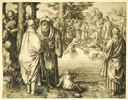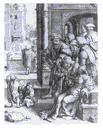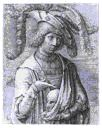Lucas van Leyden
Dutch
(about 1489/1494 – 1533)
The life of Lucas van Leyden is shrouded in mystery, full of uncertainty and supposition. (1) For centuries, authors relied heavily on Karel van Mander’s lengthy biography of Lucas in his 1604 publication Het Schilder-boeck for biographical information. In more recent times, art historians have attempted to sort fact from legend by reevaluating previously published information and scrutinizing never before examined archival material, resulting in fresh insight into the life of the elusive 16th century artist. (2) Lucas was the son of Hugo Jacobsz of Leiden and Hugo’s first wife, Marie. Hugo had five additional children, four daughters and one son. Due to the nonexistence of a baptismal record, controversy surrounds Lucas’ date of birth. Van Mander confidently states in Het Schilder-boeck that Lucas was born in Leiden in May or June of 1494; however, modern authorities believe Lucas’ date of birth to be five years earlier, in 1489. Both dates, 1494 and 1489, continue to appear in literature as the year of Lucas’ birth. In 1480, Lucas’ father, Hugo, rented a home owned by the Augustinian monastery of Hieronymusdal, a highly functional center for painting, sculpture, and manuscript illumination, and (on a smaller scale) book publishing. Brother Tymanus, a painter for the monastery of Hieronymusdal, is known to have trained Lucas, at least in part. (3) Additional early artistic training of Lucas is often attributed to his father Hugo and to the painter Cornelius Engebrechtsz. Unfortunately, no documented or signed works by Hugo are extant; therefore, most attributions to Hugo are dependent upon stylistic parallels with the work of Lucas himself. Likewise, Lucas’ involvement in the workshop of Cornelius Engebrechtsz is assumed but undocumented. Lucas made two significant journeys in his lifetime. The first, in 1521, is recorded by Albrecht Dürer (1471-1528) in his personal diary as meeting “Master Lucas who engraves in copper” in Antwerp. The second journey is described by van Mander as a trip made by Lucas at the age of thirty-three to Zeeland, Flanders, and Brabant in the company of Jan Gossaert (c.1478-1532). Following the second trip, Lucas returned home to Leiden where his health steadily deteriorated. He spent the subsequent six years often bedridden, convinced that he had been poisoned on his journey. Lucas married Lysbeth van Boschuysen, the daughter of a prominent Leiden family, in 1526. He and his wife, Lysbeth, had no children. According to the burial records of St. Pieterskerk, in 1533, after only five years of marriage, Lucas succumbed to his persistent illness. Lucas’ prints appear to have been popular during his lifetime and throughout the 16th century. In the settling of Lucas’ estate, the husband of his illegitimate daughter Marijtgen, Dammas Claesz. de Hoey, gained possession of the deceased Lucas’ engraved plates and continued to publish them for income. The plates later passed to Martini Petri of Antwerp (1500-c.1565) who reworked them. Due to the popularity of Lucas’ prints, they have been printed and copied extensively, resulting in the numerous poor impressions and various versions of images extant today. (1) A great number of texts have been published on Lucas van Leyden’s life and work. The information in this essay has been compiled from the following sources:Karel van Mander, Het Shilder-boeck, Haarlem, 1604; Max Friedlånder, From Van Eyck to Bruegel, Cornell University Press, 1981; Elise Lawton Smith, The Paintings of Lucas van Leyden, University of Missouri Press, Columbia, 1992; Ellen S. Jacobowitz and Stephanie Loeb Stepanek, The Prints of Lucas van Leyden and His Contemporaries, National Gallery of Art, Washington, D.C., 1983; Jaques Lavalleye, “Lucas van Leyden,” Pieter Bruegel the Elder and Lucas van Leyden: The Complete Engravings, Etchings, and Woodcuts, London 1967, 7-26; James Snyder, Chapter 17: The Northern Netherlands, Northern Renaissance Art: Painting, Sculpture, The Graphic Arts from 1350 to 1575, Prentice Hall Inc., Upper Saddle River, 2005, 411-431. (2) The research of two particular art historians has led to immense progress in revising the biography of Lucas van Leyden—Franz Düberg and Jeremy Bangs. (3) James Snyder, Chapter 17: The Northern Netherlands, Northern Renaissance Art: Painting, Sculpture, The Graphic Arts from 1350 to 1575, Prentice Hall Inc., Upper Saddle River, 2005, 421. Rachel Masters, 2/2015
Dutch
(about 1489/1494 – 1533)
The life of Lucas van Leyden is shrouded in mystery, full of uncertainty and supposition. (1) For centuries, authors relied heavily on Karel van Mander’s lengthy biography of Lucas in his 1604 publication Het Schilder-boeck for biographical information. In more recent times, art historians have attempted to sort fact from legend by reevaluating previously published information and scrutinizing never before examined archival material, resulting in fresh insight into the life of the elusive 16th century artist. (2) Lucas was the son of Hugo Jacobsz of Leiden and Hugo’s first wife, Marie. Hugo had five additional children, four daughters and one son. Due to the nonexistence of a baptismal record, controversy surrounds Lucas’ date of birth. Van Mander confidently states in Het Schilder-boeck that Lucas was born in Leiden in May or June of 1494; however, modern authorities believe Lucas’ date of birth to be five years earlier, in 1489. Both dates, 1494 and 1489, continue to appear in literature as the year of Lucas’ birth. In 1480, Lucas’ father, Hugo, rented a home owned by the Augustinian monastery of Hieronymusdal, a highly functional center for painting, sculpture, and manuscript illumination, and (on a smaller scale) book publishing. Brother Tymanus, a painter for the monastery of Hieronymusdal, is known to have trained Lucas, at least in part. (3) Additional early artistic training of Lucas is often attributed to his father Hugo and to the painter Cornelius Engebrechtsz. Unfortunately, no documented or signed works by Hugo are extant; therefore, most attributions to Hugo are dependent upon stylistic parallels with the work of Lucas himself. Likewise, Lucas’ involvement in the workshop of Cornelius Engebrechtsz is assumed but undocumented. Lucas made two significant journeys in his lifetime. The first, in 1521, is recorded by Albrecht Dürer (1471-1528) in his personal diary as meeting “Master Lucas who engraves in copper” in Antwerp. The second journey is described by van Mander as a trip made by Lucas at the age of thirty-three to Zeeland, Flanders, and Brabant in the company of Jan Gossaert (c.1478-1532). Following the second trip, Lucas returned home to Leiden where his health steadily deteriorated. He spent the subsequent six years often bedridden, convinced that he had been poisoned on his journey. Lucas married Lysbeth van Boschuysen, the daughter of a prominent Leiden family, in 1526. He and his wife, Lysbeth, had no children. According to the burial records of St. Pieterskerk, in 1533, after only five years of marriage, Lucas succumbed to his persistent illness. Lucas’ prints appear to have been popular during his lifetime and throughout the 16th century. In the settling of Lucas’ estate, the husband of his illegitimate daughter Marijtgen, Dammas Claesz. de Hoey, gained possession of the deceased Lucas’ engraved plates and continued to publish them for income. The plates later passed to Martini Petri of Antwerp (1500-c.1565) who reworked them. Due to the popularity of Lucas’ prints, they have been printed and copied extensively, resulting in the numerous poor impressions and various versions of images extant today. (1) A great number of texts have been published on Lucas van Leyden’s life and work. The information in this essay has been compiled from the following sources:Karel van Mander, Het Shilder-boeck, Haarlem, 1604; Max Friedlånder, From Van Eyck to Bruegel, Cornell University Press, 1981; Elise Lawton Smith, The Paintings of Lucas van Leyden, University of Missouri Press, Columbia, 1992; Ellen S. Jacobowitz and Stephanie Loeb Stepanek, The Prints of Lucas van Leyden and His Contemporaries, National Gallery of Art, Washington, D.C., 1983; Jaques Lavalleye, “Lucas van Leyden,” Pieter Bruegel the Elder and Lucas van Leyden: The Complete Engravings, Etchings, and Woodcuts, London 1967, 7-26; James Snyder, Chapter 17: The Northern Netherlands, Northern Renaissance Art: Painting, Sculpture, The Graphic Arts from 1350 to 1575, Prentice Hall Inc., Upper Saddle River, 2005, 411-431. (2) The research of two particular art historians has led to immense progress in revising the biography of Lucas van Leyden—Franz Düberg and Jeremy Bangs. (3) James Snyder, Chapter 17: The Northern Netherlands, Northern Renaissance Art: Painting, Sculpture, The Graphic Arts from 1350 to 1575, Prentice Hall Inc., Upper Saddle River, 2005, 421. Rachel Masters, 2/2015








